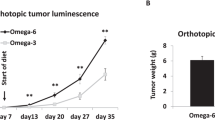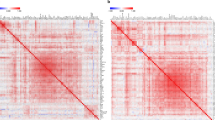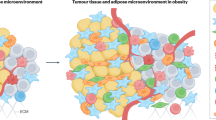Abstract
Some studies suggest that several tumors have a greater incidence in those patients with a high fat diet, such as colon, breast, and prostate. However, we wanted to determine the effects of obesity alone, independent of diet, on the progression of prostate tumor growth. Using a genetic model of obese and lean Zucker rats, we wanted to demonstrate any sera differences in the concentration of basic fibroblast growth factor (FGF-2) and vascular endothelial cell growth factor (VEGF), two important factors involved in the growth and progression of prostate cancer. We also wanted to investigate if there were any differences in immune function between the two sera, which could also account for uninhibited tumor growth, as well as differences in mitogenic stimulation. Female Zucker rat obese and lean sera were analyzed using ELISA assays for FGF-2, VEGF, and macrophage inflammatory protein-1 alpha (MIP-1a), as a measure of macrophage function. In addition, the sera of lean and obese sera were plated on wells growing LNCaP prostate cancer cells to determine differences in mitogenicity. We found a greater concentration of FGF-2 in the sera from obese Zucker rats compared to lean Zucker rats: 6.32±0.56 vs 3.48±0.34 pg/ml, respectively, P<0.05). We also demonstrated a greater concentration of VEGF in obese rat sera compared to lean sera: 54.4±4.1 vs 38.0±2.9 pg/mL, respectively, P<0.05). We detected a trend in mitogenic stimulation among LNCaP cells along the higher concentrations of the dose–response curve (0.72±0.06 vs 0.51±0.5). However, this was not statistically significant. In addition, we did not find a significant difference in MIP-1a macrophage activity levels between sera. To conclude, we speculate that the greater concentrations of VEGF and FGF-2 in the sera of obese rodents vs lean rodents may account for some of the differences seen in obesity-related tumor growth seen in the human condition. However, the lack of any sera differences of immune function, as measured by macrophage activity, as well as no significant differences on mitogenic proliferation on LNCaP prostate cancer cells, suggests that other mechanisms may exist to explain differences seen in obesity-related prostate tumor biology.
This is a preview of subscription content, access via your institution
Access options
Subscribe to this journal
Receive 4 print issues and online access
$259.00 per year
only $64.75 per issue
Buy this article
- Purchase on Springer Link
- Instant access to full article PDF
Prices may be subject to local taxes which are calculated during checkout
Similar content being viewed by others
References
Mydlo JH, Kanter JL, Kral JG, Macchia RJ . Obesity, diet and other factors in urological malignancies. A review. BJU Int 1999; 86: 1–6.
Moller H, Mellemgaard A, Lindvig K, Olsen JH . Obesity and cancer risk: A Danish record-linkage study. Eur J Cancer 1994; 30A: 344–350.
Heber D, Fair WR, Ornish D Nutrition and Prostate Cancer. CaPCURE Nutrition Project Monograph, 2nd edn. CaPCURE, Santa Monica 1998.
Saxe GA et al. Can diet in conjunction with stress reduction affect the rate of increase in prostate specific antigen after biochemical recurrence of prostate cancer? J Urol 2002; 166: 2202–2207.
Mydlo JH, Kral JG, Macchia RJ . Differences in prostate and adipose tissue basic fibroblast growth factor (FGF-2) analysis of preliminary results. Urology 1997; 50: 265–279.
Weber RV, Stein DE, Scholes J, Kral JG . Obesity potentiates AOM-induced colon cancer. Digest Dis Sci 2000; 45: 890–895.
Mydlo JH et al. A pilot study examining body mass index, serum lipids, PSA, Gleason score and race in men with and without prostate cancer. Prostate Cancer P D 2001; 4: 1–5.
Wang Y et al. Decreased growth of established human prostate LNCaP tumors in nude mice fed a low fat diet. J Natl Cancer Inst 1995; 87: 1456–1467.
Pienta KJ, Goodson JA, Esper PS . Epidemiology of prostate cancer: molecular and environmental clues. Urology 1996; 48: 676–683.
Nataabe H et al. Elevated levels of an angiogenic peptide basic FGF in the urine of patients with a wide spectrum of cancers. J Natl Cancer Inst 1994; 86: 356–364.
Nanus DM et al. Expression of bFGF in primary human renal tumors and correlation with poor survival. J Natl Cancer Inst 1993; 85: 1597–1605.
Mydlo JH et al. Heparin-binding growth factor isolated from human prostatic extracts. The Prostate 1988; 12: 343–355.
Folkman J . What is the evidence that tumors are angiogenesis dependent? J Natl Cancer Inst 1990; 82: 4–10.
Dirix LY et al. Elevated levels of the angiogenic cytokines basic fibroblast growth factor and vascular endothelial growth factor in sera of cancer patients. Br J Cancer 1997; 76: 238–242.
Chandra RK . Graying of the immune system. JAMA 1997; 277: 1398–1399.
Costello RT, Gastaut JA, Olive D . Tumor escape from immune surveillance. Arch Immuno Ther Exp 1999; 47: 83–88.
Roberts RE, Kaplan GA, Shema SJ, Strawbridge WJ . Are the obese at greater risk for depression? Am J Epidemiol 2000; 152: 163–170.
Irwin M et al. Impaired natural killer cell activity during bereavement. Brain Behav Immunity 1987; 1: 98–104.
Ben-Eliyahu S, Page GG, Yirmiya R, Shakhar G . Evidence that stress and surgical interventions promote tumor development by suppressing natural killer cell activity. Int J Cancer 1999; 80: 880–888.
Svane IM, Boesen M, Engel AM . The role of cytotoxic T-lymphocytes in the prevention and immune surveillance of tumors—lessons from normal and immunodeficient mice. Med Oncol 1999; 16: 223–238.
Maral J, Florentin I, Soubrane C, Maral R . Cancer and immunosuppression: experimental aspects. Bull Cancer 1983; 70: 351–371.
Acknowledgements
We wish to thank Ben Scoll for his help on the ELISA assays.
Author information
Authors and Affiliations
Corresponding author
Rights and permissions
About this article
Cite this article
Mydlo, J., Gerstein, M., Harris, C. et al. Immune function, mitogenicity, and angiogenic growth factor concentrations in lean and obese rodent sera: implications in obesity-related prostate tumor biology. Prostate Cancer Prostatic Dis 6, 286–289 (2003). https://doi.org/10.1038/sj.pcan.4500693
Received:
Revised:
Accepted:
Published:
Issue Date:
DOI: https://doi.org/10.1038/sj.pcan.4500693
Keywords
This article is cited by
-
Breast cancer microenvironment and obesity: challenges for therapy
Cancer and Metastasis Reviews (2022)
-
High fat-induced obesity associated with insulin-resistance increases FGF-2 content and causes stromal hyperplasia in rat ventral prostate
Cell and Tissue Research (2012)



